Tomlinson B.R. The New Cambridge History of India, Volume 3, Part 3: The Economy of Modern India, 1860-1970
Подождите немного. Документ загружается.

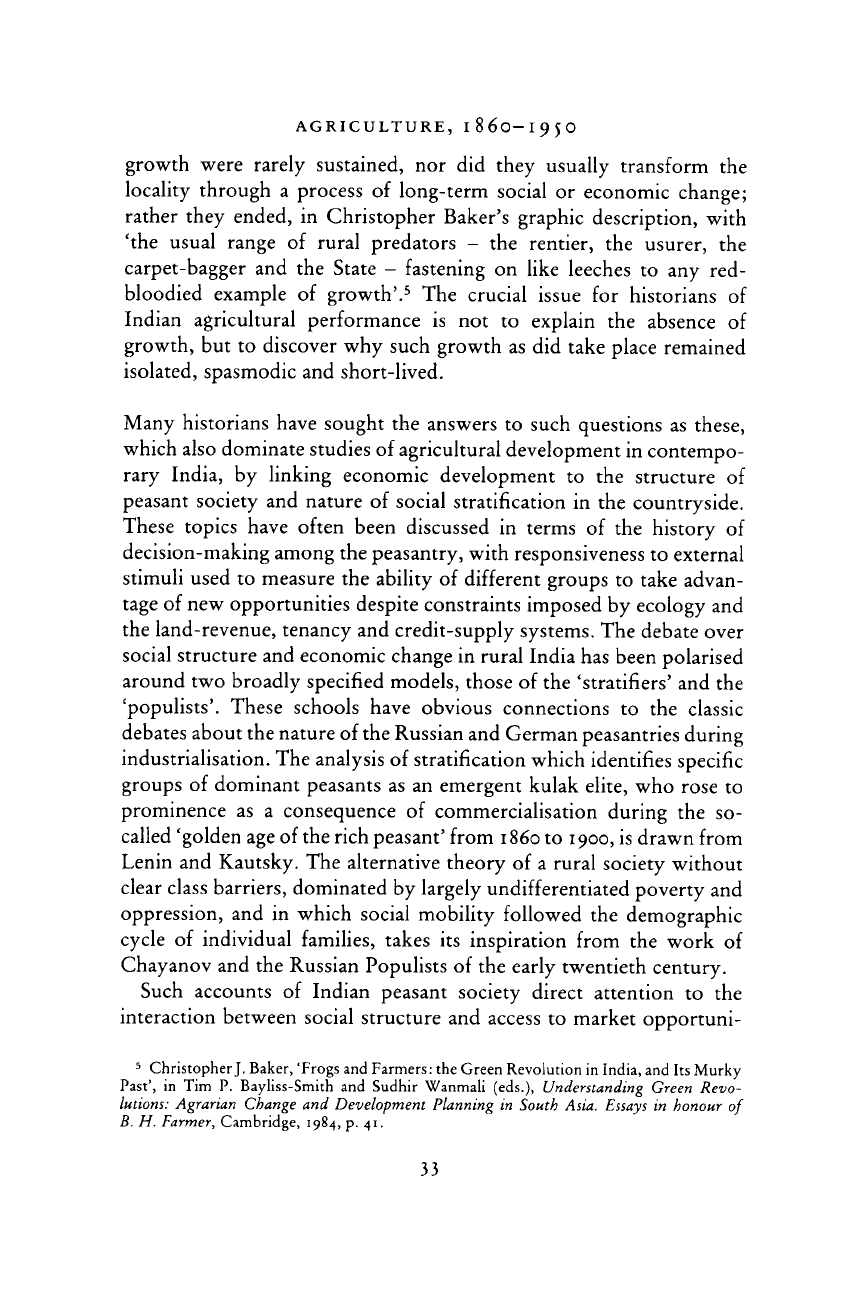
AGRICULTURE,
1860-195O
33
growth
were rarely sustained, nor did they usually transform the
locality
through a process of long-term social or economic change;
rather
they ended, in Christopher Baker's graphic description, with
f
the
usual range of
rural
predators
- the
rentier,
the
usurer,
the
carpet-bagger and the State - fastening on like leeches to any red-
bloodied
example of growth'.
5
The crucial issue for historians of
Indian agricultural performance is not to explain the absence of
growth,
but to discover why such growth as did take place remained
isolated, spasmodic and short-lived.
Many
historians have sought the answers to such questions as these,
which
also dominate studies of agricultural development in contempo-
rary India, by linking economic development to the
structure
of
peasant society and
nature
of social stratification in the countryside.
These
topics have often been discussed in
terms
of the history of
decision-making
among the peasantry, with responsiveness to external
stimuli used to measure the ability of different groups to take advan-
tage of new opportunities despite constraints imposed by
ecology
and
the land-revenue, tenancy and credit-supply systems. The debate over
social
structure
and economic change in
rural
India has been polarised
around two broadly specified models, those of the
c
stratifiers' and the
£
populists'. These schools have obvious connections to the classic
debates about the
nature
of the Russian and German peasantries during
industrialisation. The analysis of stratification which identifies specific
groups of dominant peasants as an emergent kulak elite, who rose to
prominence as a consequence of commercialisation during the so-
called
'golden age of the rich peasant' from
i860
to 1900, is drawn from
Lenin
and Kautsky. The alternative theory of a
rural
society without
clear
class barriers, dominated by largely undifferentiated poverty and
oppression, and in which social mobility
followed
the demographic
cycle
of individual families, takes its inspiration from the work of
Chayanov
and the Russian Populists of the early twentieth century.
Such
accounts of Indian peasant society direct
attention
to the
interaction between social
structure
and access to market opportuni-
5
Christopher J. Baker, 'Frogs and Farmers: the Green Revolution in India, and Its Murky
Past', in Tim P.
Bayliss-Smith
and Sudhir Wanmali (eds.), Understanding Green Revo-
lutions:
Agrarian Change and Development Planning in South Asia. Essays in honour of
B.
H. Farmer, Cambridge, 1984, p. 41.
Cambridge Histories Online © Cambridge University Press, 2008
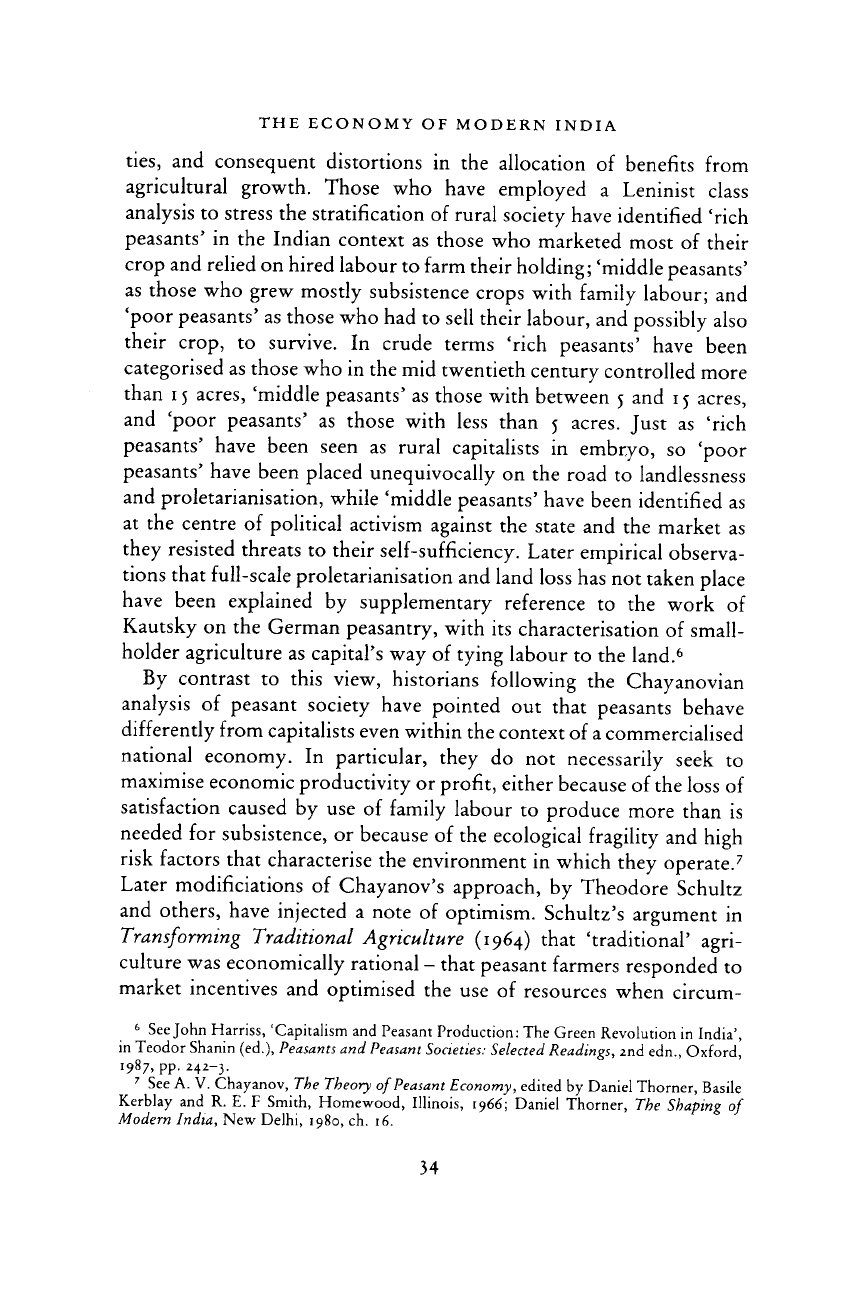
THE
ECONOMY
OF
MODERN
INDIA
ties,
and consequent distortions in the allocation of benefits from
agricultural growth. Those who have employed a Leninist class
analysis to stress the stratification of
rural
society have identified 'rich
peasants' in the Indian context as those who marketed most of their
crop and relied on hired labour to farm their holding; 'middle peasants'
as those who grew mostly subsistence crops with family labour; and
'poor peasants' as those who had to sell their labour, and possibly also
their crop, to survive. In crude
terms
'rich peasants' have been
categorised as those who in the mid twentieth century controlled more
than
15 acres, 'middle peasants' as those with between 5 and 15 acres,
and 'poor peasants' as those with less
than
5 acres.
Just
as 'rich
peasants' have been seen as
rural
capitalists in embryo, so 'poor
peasants' have been placed unequivocally on the road to landlessness
and proletarianisation, while 'middle peasants' have been identified as
at the centre of political activism against the
state
and the market as
they resisted
threats
to their self-sufficiency. Later empirical observa-
tions
that
full-scale proletarianisation and land loss has not taken place
have been explained by supplementary reference to the work of
Kautsky
on the German peasantry, with its characterisation of small-
holder agriculture as capital's way of tying labour to the land.
6
By
contrast to this
view,
historians
following
the Chayanovian
analysis of peasant society have pointed out
that
peasants behave
differently from capitalists even within the context of a commercialised
national economy. In particular, they do not necessarily seek to
maximise economic productivity or profit, either because of the loss of
satisfaction caused by use of family labour to produce more
than
is
needed for subsistence, or because of the
ecological
fragility and high
risk factors
that
characterise the environment in which they operate.
7
Later modifications of Chayanov's approach, by Theodore Schultz
and others, have injected a note of optimism. Schultz's argument in
Transforming Traditional Agriculture (1964)
that
'traditional' agri-
culture was economically rational -
that
peasant farmers responded to
market incentives and optimised the use of resources when circum-
6
See
John
Harriss, 'Capitalism and Peasant Production: The Green Revolution in India',
in Teodor Shanin (ed.), Peasants and Peasant Societies: Selected Readings, 2nd edn., Oxford,
1987,
pp. 242-3.
7
See A. V. Chayanov, The Theory of Peasant Economy, edited by Daniel Thorner, Basile
Kerblay
and R. E. F Smith, Homewood, Illinois, 1966; Daniel Thorner, The Shaping of
Modern India, New Delhi, 1980, ch. 16.
34
Cambridge Histories Online © Cambridge University Press, 2008
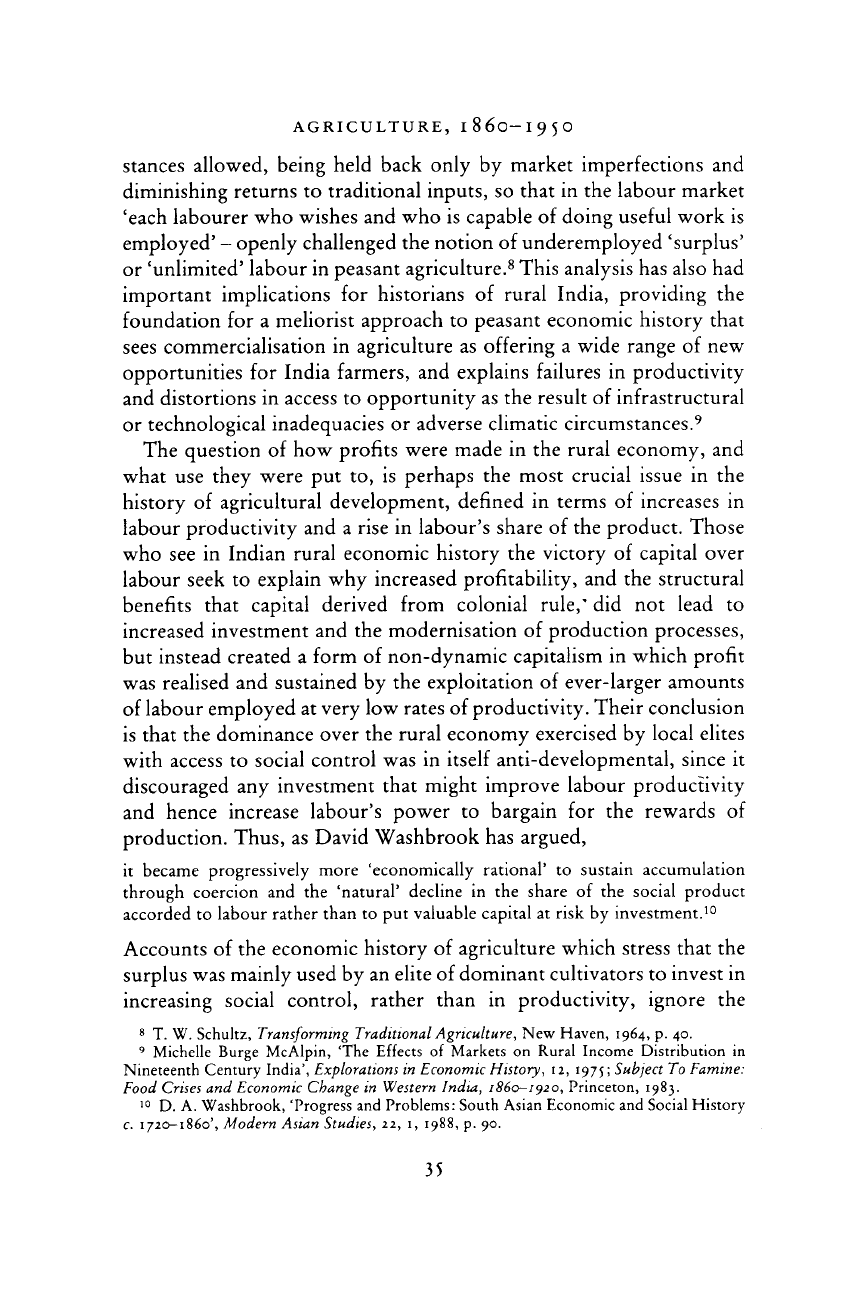
AGRICULTURE,
1860-I95O
stances allowed, being held back only
by
market imperfections
and
diminishing
returns
to
traditional inputs,
so
that
in the
labour market
'each
labourer who wishes
and
who
is
capable
of
doing useful work
is
employed'
-
openly challenged
the
notion
of
underemployed 'surplus'
or 'unlimited' labour
in
peasant agriculture.
8
This analysis has also
had
important
implications
for
historians
of
rural
India, providing
the
foundation
for a
meliorist approach
to
peasant economic history
that
sees
commercialisation
in
agriculture
as
offering
a
wide range
of
new
opportunities
for
India farmers,
and
explains failures
in
productivity
and distortions
in
access
to
opportunity
as the
result
of
infrastructural
or technological inadequacies
or
adverse climatic circumstances.
9
The
question
of
how profits were made
in the
rural
economy,
and
what
use
they were
put to, is
perhaps
the
most crucial issue
in the
history
of
agricultural development, defined
in
terms
of
increases
in
labour productivity
and a
rise
in
labour's
share
of the
product. Those
who
see in
Indian
rural
economic history
the
victory
of
capital over
labour seek
to
explain why increased profitability,
and the
structural
benefits
that
capital derived from colonial rule,'
did not
lead
to
increased investment
and the
modernisation
of
production processes,
but instead created
a
form
of
non-dynamic capitalism
in
which profit
was
realised
and
sustained
by the
exploitation
of
ever-larger amounts
of
labour employed
at
very low
rates
of productivity. Their conclusion
is
that
the
dominance over
the
rural
economy exercised
by
local elites
with
access
to
social control was
in
itself anti-developmental, since
it
discouraged
any
investment
that
might improve labour productivity
and hence increase labour's power
to
bargain
for the
rewards
of
production. Thus,
as
David Washbrook has argued,
it became progressively more 'economically rational' to sustain accumulation
through coercion and the 'natural' decline in the share of the social product
accorded
to labour
rather
than to put valuable capital at risk by investment.
10
Accounts
of the
economic history
of
agriculture which stress
that
the
surplus was mainly used
by an
elite of dominant cultivators
to
invest
in
increasing social control,
rather
than
in
productivity, ignore
the
8
T. W.
Schultz,
Transforming Traditional Agriculture, New Haven, 1964,
p. 40.
9
Michelle
Bürge
McAlpin,
'The
Effects
of
Markets
on
Rural Income Distribution
in
Nineteenth Century India', Explorations
in
Economic History, 12,
1975;
Subject
To
Famine:
Food
Crises
and
Economic Change
in
Western India,
i860-1920,
Princeton, 1983.
10
D. A.
Washbrook, 'Progress
and
Problems: South
Asian
Economic
and
Social
History
c.
1720-1860',
Modern Asian Studies,
22, 1,
1988,
p. 90.
35
Cambridge Histories Online © Cambridge University Press, 2008

THE
ECONOMY
OF
MODERN INDIA
transactions costs and problems of labour management
that
exist even
in a labour-surplus economy, and the investments
that
have taken place
in labour-saving technology or capital-intensive agriculture to over-
come them. There are also difficulties in using dominant class models
of
peasant society too rigidly to analyse Indian conditions. The
different social
strata
of the Indian countryside across regions were not
always
distinct in their ownership of land or capital, nor were
dominant groups in rural society necessarily the closed elite character-
istic of a class-based social system. Furthermore, in most
parts
of the
country the peasant mode of production never
fully
resolved itself into
a class structure based on labour and capital. Rich peasants rarely
became rentiers; poor peasants did not often suffer
full
proletariani-
sation by losing access to land entirely. By the twentieth century the
majority of cultivating households did not have access to enough land
to obtain subsistence, but even the small parcels of land they secured
were important for psychic and social reasons, and gave them the
option of family self-exploitation
that
brought some advantages in the
labour market.
These
issues have been approached in a very different way by those
historians who doubt the existence of a large enough surplus, or a
sufficiently
vigorous market stimulus, to encourage or maintain pro-
ductive rural investment. They suggest
that
sustained agricultural
development required investment in production, and such investment
had to be fuelled by profits; although growth from below in the rural
economy
may have been possible in the nineteenth century autimes of
maximum market growth, this form of development was overwhelmed
after 1900 by adverse circumstances and Malthusian traps. According
to Eric Stokes, for example, the lessons of the short-lived wheat boom
in Central India in the 1880s were
that,
what appears to have been ... fundamental in turning enterprise wholeheartedly
into agricultural production
rather
than
investment in
rent
property, moneylend-
ing
or middle-man marketing was the crude
rate
of net agricultural profits It
has been the difficulty of sustaining a high
rate
of profit... for sufficiently long
that
makes Indian agrarian history so often the story of short-lived booms
followed
by
long
periods when the landholder diversifies his sources of income and puts his
eggs
into many baskets.
11
11
Eric Stokes,
The
Peasant
and the Raj.
Studies
in
Agrarian Society
and
Peasant Rebellion,
in Colonial India, Cambridge, 1978,
pp.
13-14.
36
Cambridge Histories Online © Cambridge University Press, 2008
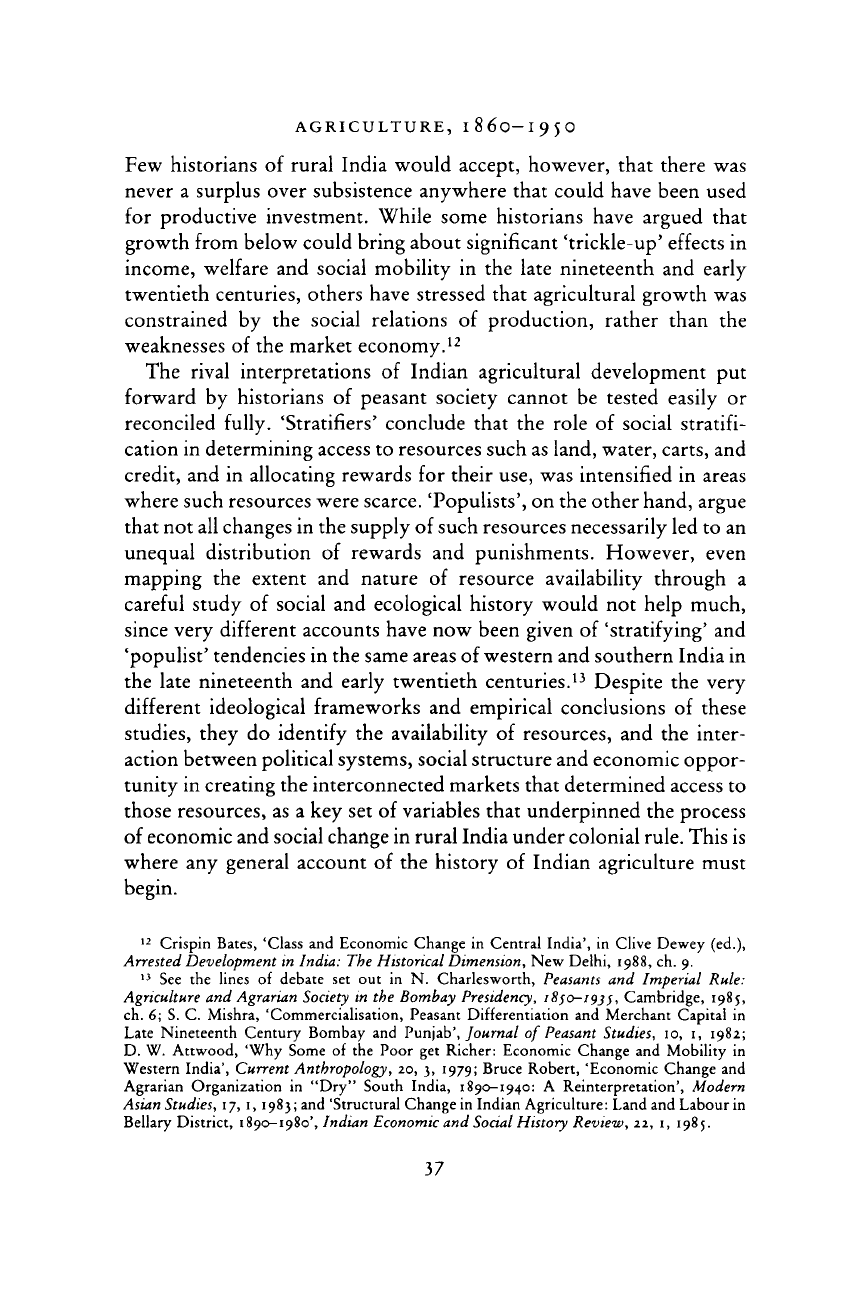
AGRICULTURE,
1860-I95O
37
Few
historians of
rural
India would accept, however,
that
there
was
never a surplus over subsistence anywhere
that
could have been used
for
productive investment. While some historians have argued
that
growth from below could bring about significant 'trickle-up' effects in
income, welfare and social mobility in the late nineteenth and early
twentieth centuries, others have stressed
that
agricultural growth was
constrained by the social relations of production,
rather
than
the
weaknesses of the market economy.
12
The
rival
interpretations
of Indian agricultural development put
forward by historians of peasant society cannot be tested easily or
reconciled
fully.
'Stratifiers' conclude
that
the role of social stratifi-
cation in determining access to resources such as land, water, carts, and
credit, and in allocating rewards for their use, was intensified in areas
where such resources were scarce. 'Populists', on the other
hand,
argue
that
not all changes in the supply of such resources necessarily led to an
unequal distribution of rewards and punishments. However, even
mapping the extent and
nature
of resource availability through a
careful
study of social and ecological history would not help much,
since very different accounts have now been given of 'stratifying' and
'populist' tendencies in the same areas of western and southern India in
the late nineteenth and early twentieth centuries.
13
Despite the very
different ideological frameworks and empirical conclusions of these
studies, they do identify the availability of resources, and the
inter-
action between political systems, social
structure
and economic oppor-
tunity in creating the interconnected markets
that
determined access to
those resources, as a key set of variables
that
underpinned the process
of
economic and social change in
rural
India
under
colonial rule. This is
where any general account of the history of Indian agriculture must
begin.
12
Crispin Bates,
'Class
and Economic Change in Central India', in
Clive
Dewey
(ed.),
Arrested
Development in India: The Historical Dimension, New
Delhi,
1988, ch. 9.
13
See the lines of debate set out in N. Charlesworth, Peasants and Imperial Rule:
Agriculture and Agrarian Society in the Bombay Presidency,
1850-1935,
Cambridge, 1985,
ch.
6; S. C. Mishra, 'Commercialisation, Peasant Differentiation and Merchant Capital in
Late
Nineteenth Century Bombay and Punjab', Journal of Peasant Studies, 10, 1, 1982;
D.
W. Attwood, 'Why Some of the Poor get Richer: Economic Change and Mobility in
Western India', Current Anthropology, 20, 3, 1979; Bruce Robert, 'Economic Change and
Agrarian
Organization in "Dry" South India, 1890-1940: A Reinterpretation', Modern
Asian Studies, 17, 1, 1983; and 'Structural Change in Indian Agriculture: Land and Labour in
Bellary
District, 1890-1980', Indian Economic and Social History Review, 22, 1, 1985.
Cambridge Histories Online © Cambridge University Press, 2008

THE
ECONOMY
OF
MODERN
INDIA
Between
1765 and 1820 the British East Indian Company came to
exercise
political domination of most of peninsular South
Asia,
replacing
the old Mughal empire and the autonomous and semi-
autonomous successor states
that
it had spawned. The rural economy
that
the British now ruled was varied and complex, and it is clear
that
in
the eighteenth century the Indian countryside was far from being the
sort of 'stationary' society or economy, devoid of capital accumulation
or technical advance, the classical political economists took it to be. In
reality agricultural colonisation and investment were widespread,
although with many local variations and fluctuations, as new crops
were
produced for an extensive internal market. In some
parts
of
north
India, for example, considerable agricultural entrepreneurs had
emerged, who could mobilise men and money to colonise new land for
profit, while in the south the regime of Hyder Ali and Tipu Sultan in
Mysore
asserted dominance over the economy in
return
for direct
investment in irrigation and cultivation. Elsewhere, peasant
brotherhoods, or individual families, were capable of expanding exten-
sive
cultivation of dry land as physical security and economic oppor-
tunity allowed. The commercial economy was sufficiently widespread
in many areas to allow regional specialisation in different crops and
cultivation
systems, bound together by networks of
trade
and credit
that
covered considerably distances and many levels of operation.
The
agrarian commercial economy of the eighteenth century was
largely
organised on mercantilist principles, as the decentralisation of
the Mughal empire led to the creation of independent or semi-
independent subordinate fiefdoms, controlled by regional and local
officials,
military strongmen and political magnates. These states were
driven by the requirements of 'military fiscalism', which determined
the arrangements they made to secure revenue, supplies and support
for
their defence and expansion. Urban merchants and rural entre-
preneurs who could supply cash, men or material to the
state
were
rewarded with tax concessions and local power; market networks
developed
that
met the needs of these internal
patterns
of demand, as
well
as serving the external requirements represented by the English
East India Company and other foreign traders.
At
the local
level,
agricultural production and rural social and
political
relations were determined by a complex mixture of
ecological,
customary and technological factors as
well
as by the military and
38
Cambridge Histories Online © Cambridge University Press, 2008

(') Mean annual rainfall
40-100ins
(1016-2540mm)L
№ Millets
(JAWARANDBAJRA)
One
dot
represents
/f-y*
100,000 acres (40,469
ha)
('"') Rice
r'^
3
One dot
represents
) V^^A
100.000 acres (40.469 ha.)
\.
-'iff 0
500 km
0 500 miles
(IV) Wheat
One dot represents
!
V~'~v
100.000 acres (40,469 ha.)
2.i
Average
annual rainfall and staple foodgrain production, 1938-9. The
crop production data are not complete for all the Princely States of Orissa,
Cutch,
Rajputana and Central India.
39
Cambridge Histories Online © Cambridge University Press, 2008

THE
ECONOMY
OF
MODERN
INDIA
political
superstructure
imposed by the new regional states of the
eighteenth and early nineteenth centuries. One consistent variation
in the density and complexity of production and distribution systems
was
caused by the presence or absence of effective irrigation, between
'wet'
and 'dry' lands, each of which had distinctive
patterns
of
agrarian relations.
14
While this distinction should not be taken to
imply
a simple ecologically determined
interpretation
of agrarian
history, it is possible to delineate
c
wet' and 'dry' areas roughly by
mapping the extent of irrigation and the spread of the main foodgrain
crops,
as in map 2.1
The
'wet', well-watered rice-growing areas of the agricultural
heart-
lands of the great river deltas sustained the hubs of traditional
civilisation.
Structured and hierarchical, with extensive
urban
and
cultural centres, these areas depended on capital and labour-intensive
rice
cultivation, with rigid social distinction between the
status
of the
landowners (high-caste, often Brahmin) and the labourers (low-caste,
often
untouchable). They were already supporting very high popu-
lation densities by the eighteenth century, and could not easily expand
further without exhausting the soil. By contrast, the 'dry' areas of
upland India, notable in the Deccan, the Punjab and western Gangetic
plain, were sparsely settled, semi-arid and grew millets and wheats
irrigated by
wells.
Here agriculture was extensive, with long fallow
periods, and was largely (and best) organised by peasant families
cropping their own lands. Free land, of a sort, was usually available,
and the levers of productive and social power were more finely
balanced, favouring decisively only those who could impose a mono-
poly
on access to security, irrigation, or infrastructure - the keys to the
successful
development of such regions. In some 'dry' areas new crops,
new
irrigation and new
transport
links were to lead to considerable
expansion in the nineteenth century, especially where they allowed
new
frontiers to be opened up.
There was no substantial international market for Indian agricultural
produce in the eighteenth century. Attempts to supplement exports of
cloth
to Britain with sugar, indigo and pepper were largely unsuccess-
ful
(indigo and sugar being unable to compete with new sources of
14
David
Ludden, 'Productive Power in Agriculture: A Survey of Work on the
Local
History
of British India', in Meghnad Desai et al.
y
(eds.), Agrarian Power and Agricultural
Productivity in South Asia,
Berkeley,
1984, pp. 76-8.
40
Cambridge Histories Online © Cambridge University Press, 2008
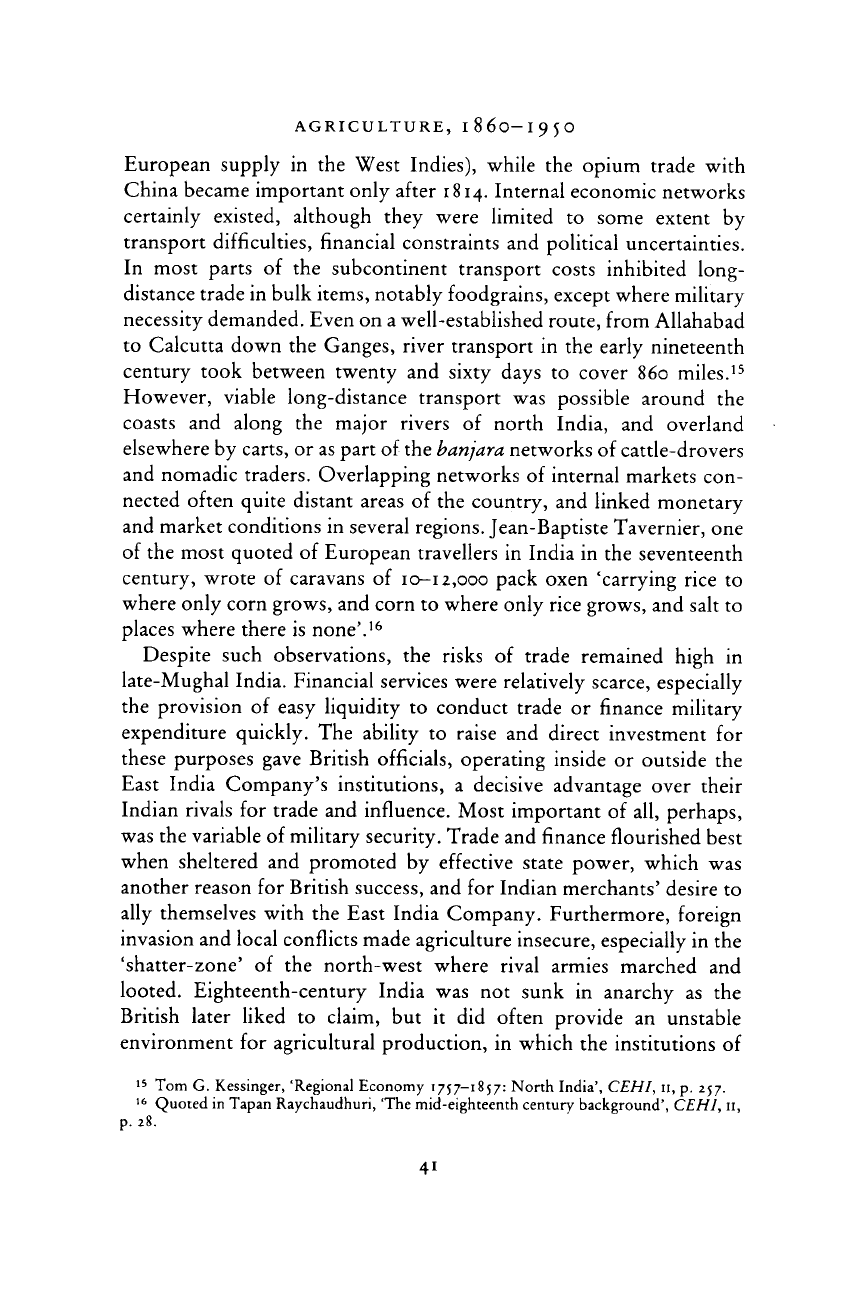
AGRICULTURE,
1860-I95O
European supply in the West Indies), while the opium
trade
with
China
became important only after
1814.
Internal economic networks
certainly existed, although they were limited to some extent by
transport
difficulties, financial constraints and political uncertainties.
In most
parts
of the subcontinent
transport
costs inhibited long-
distance
trade
in bulk items, notably foodgrains, except where military
necessity
demanded. Even on a well-established route, from Allahabad
to Calcutta down the Ganges, river
transport
in the early nineteenth
century took between twenty and sixty days to cover 860 miles.
15
However,
viable long-distance
transport
was possible around the
coasts and along the major rivers of
north
India, and overland
elsewhere
by carts, or as
part
of the banjara networks of cattle-drovers
and nomadic traders. Overlapping networks of internal markets con-
nected often quite distant areas of the country, and linked monetary
and market conditions in several regions. Jean-Baptiste Tavernier, one
of
the most quoted of European travellers in India in the seventeenth
century, wrote of caravans of 10-12,000 pack oxen 'carrying rice to
where only corn
grows,
and corn to where only rice
grows,
and salt to
places
where there is none'.
16
Despite
such observations, the risks of
trade
remained high in
late-Mughal
India. Financial services were relatively scarce, especially
the provision of easy liquidity to conduct
trade
or finance military
expenditure quickly. The ability to raise and direct investment for
these purposes
gave
British
officials,
operating inside or outside the
East India Company's institutions, a decisive advantage over their
Indian rivals for
trade
and influence. Most important of all, perhaps,
was
the variable of military security. Trade and finance flourished best
when
sheltered and promoted by
effective
state power, which was
another reason for British success, and for Indian merchants' desire to
ally
themselves with the East India Company. Furthermore, foreign
invasion
and local conflicts made agriculture insecure, especially in the
'shatter-zone' of the north-west where rival armies marched and
looted.
Eighteenth-century India was not sunk in anarchy as the
British
later liked to claim, but it did often provide an unstable
environment for agricultural production, in which the institutions of
15
Tom G. Kessinger, 'Regional Economy
1757-1857:
North India',
CEHI>
11,
p. 257.
16
Quoted in Tapan Raychaudhuri, 'The mid-eighteenth century background', CEHI,
11,
p.
28.
41
Cambridge Histories Online © Cambridge University Press, 2008

THE
ECONOMY
OF
MODERN
INDIA
market integration and productive investment were only as secure as
the
state
power and political influence on which they were based.
Over
the course of the nineteenth century the British changed and
adapted the economic, political and social institutions of rural India
fundamentally, with effects
that
were as often destructive of old
development systems as they were creative in building new links. The
most obvious impact of British rule on the rural economy was through
the imposition of new systems of land revenue. Agricultural taxation
provided an important source of revenue for any Indian government,
and especially for the Company which had to pay a dividend by using
its surplus to purchase Indian goods for sale in Britain. The land-tax
system
also provided the focal point for the state's relations with the
society
it ruled, and Company officials believed
that
their Indian
subjects would judge them by the degree of continuity and security
that
they provided, for only
thus
could improvements in agricultural
output and living standards be achieved.
Creating
an adequate administrative system of this type caused
par-
ticular problems in the Bengal Presidency, the first area of India to come
under direct British control. The main difficulty here concerned the
Company's
relations with the large zamindars, rural magnates who had
built up hereditary fiscal powers as agents and tax farmers for the
Nawabs
of
Bengal.
British officials generally agreed
that
the position of
such men would have to be maintained since rural society required con-
tinuity and stability and a stable landlord class would promote social
order. For these reasons it was decided in the 1790s
that
a permanent
settlement should be made, giving rights in land to zamindars in per-
petuity, provided
that
they continued to pay their revenue. Security of
property rights was also intended to
give
landlords an incentive to
improve their land, increasing the
rent
they could charge, and hence the
profit they could make over the fixed land-revenue demand. Since the
Bengal
administration did not have the capacity for detailed assessments
of
agricultural output or
value,
it decided to fix the
level
of land revenue
at the highest
level
previously imposed,
that
of 1789-90, resulting in a
demand perhaps 20 per cent higher
than
that
made before
1757.
17
17
This account of the Permanent Settlement and its consequences is based largely on P. J.
Marshall,
Bengal: The British Bridgehead. Eastern India
1/40-1828,
New Cambridge
History
of India, Volume
11.2,
Cambridge, 1987, ch. 4.
4*
Cambridge Histories Online © Cambridge University Press, 2008
